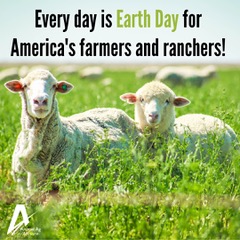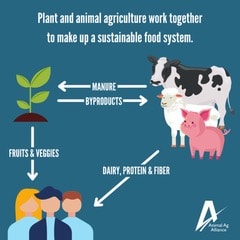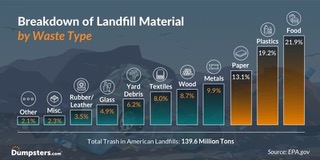
We have more people to feed with less land and our natural resources are showing their age. What are the solutions? Who are the problem solvers? We all eat; therefore, we all have a role. We have areas to improve but progress has been made. Earth Day is every day — how will you invest in the planet?
From the Ground Up
Whether it’s a designated day or any day, farmers, ranchers, agriculturists and scientists throughout the food chain know the importance of improving their practices on a continuous basis over the years. That is sustainability. Today, one farmer supplies food for 166 people globally compared to only 26 in 1960. That is investment. We produce more crops per bushel and milk or meat per dairy or beef cow due to investing in technology and sustainable practices. For example, today we can produce five times the bushels of corn per acre or double the pound of beef per live animal than in the mid 1940s.
However, how we grow, transport and consume food is more than “talk” among the few. The conversations (and conflicts) centered around Earth Day — sustainability, climate change, regenerative agriculture and food waste — create headlines beyond the farm … and highlight the reality that everything we do or don’t do impacts the environment.
Just the Facts
We often focus on what we eat and grow as our main environmental issue and point of contention. However, let’s look at the facts:
- Transportation is the largest source of U.S. emissions, surpassing electricity generation in the past few years. Transportation and electricity generation almost entirely contribute to emissions through fossil fuel combustion, which produces carbon dioxide.
- During the pandemic, energy-related carbon dioxide emissions were 11% lower than 2019, partly due to travel restrictions. With less driving and flying, the statics showed a 13% drop in motor gasoline emissions and a 38% drop in jet fuel emissions. Just this reduction was responsible for nearly half of the CO2 reduction during 2020! 2
- Agriculture practices contribute to greenhouse emissions but at a significantly lower percentage than the three previously mentioned areas or what is frequently reported.
- The agriculture industry accounts for 9.9% of GHG (greenhouse gas) emissions in the United States and roughly 13% globally. But the good news is that agriculture is the only sector with the natural potential to be net negative for GHG emissions.3
- Soil and farmlands sequester 100 more times the carbon than is emitted in a year, and with the continued efforts of “climate smart” or “regenerative” farming practices like cover crops, no tillage planting and managed use of grazing pastures, the ability to enhance carbon recovery will continue.3
- Animal agriculture plays a key role in the carbon recovery cycle. With the heightened focus on climate change, a carbon credit system that is economically viable and environmentally sound is a hot topic of discussion.4
Turning Trash into Treasures — Our Investment
It’s often said, “one man’s trash is another man’s treasures.” When it comes to trash in general, and especially food, I’m not sure any of us can find the treasures. After all, as a society we are trashy! According to the USA Facts.org, the average American generated 4.9 pounds of solid trash (food waste, paper, etc.) daily while a family creates about 18 pounds. In a year, that’s equal to 1,642 pounds per person and 6,570 pounds per family. Over 40% of what’s in our landfills is plastic and food according to Dumpsters.com.5
It’s always easier to assess what others “should be doing” than evaluating our own actions. As consumers, we expect our food supply system to improve its environment footprint. But do we realize that we, as individuals, can make the greatest impact with the least amount of financial investment? We just must make the commitment.
Small Steps Yield Big Dividends
What can we do better?
- Reduce food waste. Have a plan when it comes to purchasing food. Food costs have increased and now is not the time to waste. Buy what you’ll prepare and eat in a few days. Learn more in my recent blog “Sustainability Starts at Home.”
- Have a plan for leftovers. Think new creations not leftovers. Give wilted vegetables new life in cold water or roast and use or freeze! Check out my recent blog “Let’s Ring Out the Old (Habits) & Zero in on Food Waste in 2022” highlighting Rosanne Rust’s book Zero Waste Cooking.
- Stop peeling vegetables like potatoes and carrots. Start composting for backyard garden or participate in a community composting project.
- Think seasonal for fresh fruits and vegetables! A majority of our “out of season” produce is exported. We can reduce the carbon footprint of produce If we eat only the fresh produce available during the growing season in our geographic location.
- Reduce daily plastic use from grocery bags to plastic bottles! Old habits are hard to break if the culture around us doesn’t promote it. When I worked in Washington, D.C., plastic bags cost six cents each. Even though minimal, the habit of always carrying a cloth bag was created but has regressed. By keeping cloth bags available, we reduce the number of bags to carry and most importantly, reduce our trash content.
- Monitor your plastic bottle use. If bottled or sparkling water is a top priority look for reusable bottles or make your own sparkling water — a step that I’ve taken over the past year. Not only do I drink more water, but the plastic bottle trash has been reduced significantly.
- Use real plates, glasses and flatware. Not only is paper trash reduced but the food on your plate looks and “tastes” better … and it’s more economical. Using a dishwasher is more environmental friendly than tossing paper.
“Be the change we wish to see in the world.” Make Earth Day 2022 the time to make a personal investment to improve the environment around us. Our small steps will yield a significant return on our investment!
References:
1. Earthday.org
2. “How do energy and emissions in the United States compare to the rest of the world?” USA Facts, Earth Day Facts, Energy & Emissions.
3. “Initiative to Reduce Greenhouse Gas Emissions in Agriculture Marks One Year Anniversary, Welcomes First Partner,” Foundation for Food & Agriculture Research, posted on Globe News Wire, April 13, 2021.
4. “Regenerative Agriculture as an Agent of Positive Change,” by Ian Pigott, Farm Journal, Global Farmer Network, April 18, 2021.
5. “Curbing America’s Trash Production: Statistics and Solutions,” by Juliana McDonald, April 4, 2022, Dumpsters.com.


